Business card plane
Impressed by a website of business card (55 x 91 mm) paper
airplane , I'm trying to make mini card plane too. Small size
plane is not gliding well like large size plane, because
aerodynamics parameter is different and drag of viscosity is
relatively large. However small size plane is relatively strong,
so more unique shape plane could be make.
Seagull 1
Seabirds should fly long distance, so they
have high performance, large aspect ratio wings. This small paper
seagull have simple structure, and fly well.
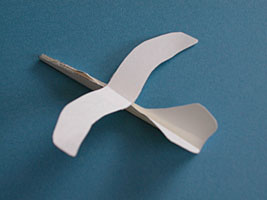
Drawing of Seagull1 set of 8 (pdf
file)
How to make Seagull 1
Download the drawing and print it on card stock. Cut the paper
according to the thick line. Fold up as dash and dot line " _
. _ . _" , and fold down as dash line " - - - - " Dihedral angle of
wings is 10 degrees. Fold tail fin as V shape (45 degrees). It works
as holizontal and vertical tail wings. Bend up back edge of main
wings tip slightly.
Dragonfly
Dragonfly had already been flying at about 3 hundred million years
ago. Perhaps no evolution is needed to fly well any longer for
them. It is also aerodynamically efficient and flies well even
if it becomes a paper airplane. In order to align the center of
gravity, the thin side (upper right of the image) is the front and
the wide side is the back.
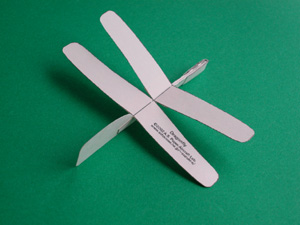
Drawing of Dragonfly set of 8 (pdf file)
How to make Dragonfly
Download the drawing and print it on card stock. Cut the paper
according to the thick line. Fold up as dash and dot line " _
. _ . _" , and fold down as dash line " - - - - " Dihedral angle of
front wings is 15 degrees. Back wings ("Dragnfly" and logo are
printed.) should be turn 180 degree and have no dihedral angle.
Bat
If it continues
with a bird and an insect, the representation bat which flies in
the sky by the mammals too cannot but participate.
A bat is the group which counts 1000 of 4000 sorts of mammals
which survive in a their present location ball, and is very
prosperous in the number of seeds, and 33 of about 100 sorts of
mammals on land are things with bats also in Japan.
Although five corners are located on the outside of wings, it is
equivalent to five fingers, respectively.
As a paper airplane, although it is a non-tail
(non-horizontal stabilizer) and the ambitious work ? in a
swept-forward wing, you may be stabilized, and it flies.
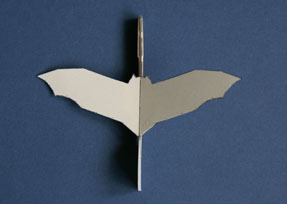
Drawing of Bat set of 8 (pdf
file)
How to make Bat
A plan is downloaded and it prints on card paper.
Two sheets could be horizontally located in a line, and it united
with the width of A4.
It clips along a thick line.
The body makes correctly each crease (a dotted line is a mountain
fold and an alternate long and short dash line is a valley fold) by
ruler beforehand.
The front part of the body is inserted in inside, and it sticks
rectangular parts (a balance weight and nose-of-an-airplane cover
combination) so that a nose of an airplane may be covered.
Wings attach the dihedral angle of about 15 degrees, and twist the
trailing edge of the outside of wings downward slightly (an outside
angle of attack is enlarged slightly).
The center of gravity is designed only under the weight of paper to
suit.
Frying fish
Fish also flies to a bird, an
insect and the mammals in line. After accelerating in the water to
escape from a big fish, the flying fish be distinctive in the air,
and do the pectoral which developed, the tail and fins with the
long lower half part are left in the water and more are
accelerated, and, several, 100 m, one in the air, it planes. There
is also a kind for which a ventral is used like a level tail
assembly. This business card airplane often also flies at high
speed.
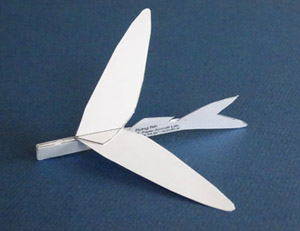
Drawing of Flying Fish Set of 8 (pdf file)
Way of making flying fish.
I download a plan and print in a card paper of A4. 2 pdf files
were placed on the side and it was added to the width of A4.
It's clipped along a thick line. A body can thrust at the
respective folds (by a dotted line, by a mountain collapse and
dash-dot, valley collapse) with a ruler correctly beforehand. A
front of a body is inserted inside, and a rectangular part (a
balance weight and a nose of a plane, cover both use) is stuck
so that I may cover a nose of a plane. A wing is a separateness
of left and right. One is made reverse, and it's pasted together
so that a thin arrow (centerline of a wing) may be.
Even if it isn't put, the dihedral angle is good. A trailing
edge in both ends of a wing is twisted up to the top a little.
I'm designing so that the center of gravity may agree on only
the weight of the paper.
Pteranodon
An ancient creature also appeared as the
representative of a reptile who flies in the air. Pteranpdon is
one kind of pterodactyls which were ruling the sky approximately
80,000,000 years ago. A dinosaur was one kind of different
reptiles, and a pterodactyl was ruling the sky in the Mesozoic
era. It's different from the present bird, light wing made from a
film of skin (It was similar to a bat.) was expanded by a bone
equivalent to an arm and the ring finger, and I was flying in the
air. Much kind of fossil is found, but one of the most famous
seeds is Pteranodon in the pterodactyl, and a big sharp comb is
the feature. When a wing is opened, the big creature who also
reaches 7-9m, but it's thought that weighed only15 about 20
kilogram. One on the sea, 100km also planes and it's said that
they were catching a fish by a toothless bill. It's said that
there are an actual pterodactyl and the seed in which I had the
performance which equals a glider for present-day plays (lift to
drag ratio). Mostly, just beside, it's the tail assembly structure
without which spreads, with the paper airplane which becomes
stable, and it flies very well so that it doesn't seem in spite of
business card size. There are no tails like this fuselage
(vertical tail) in still real Pteranodon, but the paper airplane
becomes unstable and doesn't fly without fuselage.I think this is
the smallest paper Pteranodon which flies well, ever in the world.
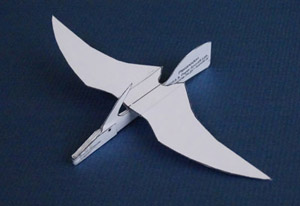
Drawing of Pteranodon set of 10 (pdf
file)
Way of making Pteranodon
Download a drawing and print in a card paper of A4. It's clipped
along a thick line. A body can thrust at the respective folds (by a
dotted line, by a mountain collapse and dash-dot, valley collapse)
with a ruler correctly beforehand. A front of a body is inserted
inside, and an eye and beak's drawn part (a balance weight and a
nose of a plane, cover both use) are stuck so that It may cover a
nose of a plane. A wing is a separateness of left and right. It's
pasted together so that a thin line (center line of a wing) may be
identical. Even if a dihedral angle isn't put, it's good, or maybe
it may be put on a little. A trailing edge in a part of 2 triangles
behind the place near the center of the wing (It's equivalent to a
foot of Pteranodon.) is twisted up to the top a little.
Surprisingly, pitch stability of the structure is kept tail
assembly-lessly only with this. I'm designing so that the center of
gravity may agree on only the weight of the paper.
Flight of the ancient Pteranodon to examine from a business card
size paper Pteranodon -Pteranodon flew at
8m/s (18mph)- original article by Akihiko Suzuki
As Pteranodon of the business card airplane flew very well, I
decided to imagine the flight of the Pteranodon 80 million years ago
from the flight of small paper Pteranodon.
It is necessary for lift to match with the weight so that a bird and
an airplane do a straight line flight. When lift refers to the
relations of the airspeed in an expression, it is L=CLρV2S/2
(L: lift, CL: lift coefficient, ρ: air density, V:
airspeed, S: wing area), and the lift is proportional to the
square of the airspeed. It becomes V= √ 2L/SCLρ when I
transform an expression, and, as for the airspeed, it is revealed
that I am proportional to √ (the square root) of the body weight per
wing area namely the wing loading L/S, the level flight per
wing area if a lift coefficient and air density are the same as it
matches with body weight. (in the case of gliding, the lift is the
ingredient which is perpendicular to the heading among gravity
exactly, but is the approximately same as gravity when lift drag
ratio is good. (98.6% more gravitational than the Pythagorean
theorem at lift drag ratio 6:1) When measured the airspeed of the
business card Pteranodon which made with paper of 209 g/m2,
the airspeed was 3.75m/s as flew in 6.0m in 1.6 seconds. The weight
of paper Pteranodon is 0.76g and the wing area are 14.0cm2
so L/S is 0.054g/cm2 , it is 0.54 kg/m2
at a unit used by airplane. I decided to compare it whether
relations of the L/S to this airspeed were similar in the real
birds. According to the data of site "Huh the Bird" http://akaitori.tobiiro.jp/yokumen.html,
which attracted the weight of many birds, a wing area, loading, air
speeds, as for the gull, the L/S for 0.328 g/cm2 that is
3.28 kg/m2 as for 9.2m/s of airspeed. Wandering albatross
has the L/S 1.40 g/cm2 (14.0 kg/m2) and
airspeed is 19.2m/s. With the airspeed and L/S of the business card
Pteranodon, it calculated that the gull fly at 3.75m/s * √ 3.28/0.54
= 9.24m/s, as for the wandering albatross fly at 3.75 * √ 14.0/0.54
= 19.1m/s. These calculated value from airspeed, L/S of paper
Preranodon and a real airspeed of birds agree surprisingly, and it
may be said that "the business card Pteranodon coefficient" is
proper, regardless of the difference in size or flight speed, that
is, regardless of the difference in Reynolds number. It is thought
that the Pteranodon glides like a gull and an albatross over the sea
and lived, and it is thought that the same coefficient comes under
it. Well, it is thought that the Pteranodon was wing open long 7-9m,
around 15-20 kg in weight (Wikipedia). I take the interval, and, as
for the wing area, 5285 of the square increases twice as much if it
was 8m, 17.5 kg if the wing open length is 72.7 times similar figure
of the business card Pteranodon (11cm), but the business card
Pteranodon is doing aspect ratio slightly small (8.64) to keep
stability and strength, and the wing area is calculated with 7.1m2
at 5,075 times as the real Pteranodon is aspect ratio around 9.0
(Wikipedia). The L/S becomes 2.46 kg/m2. It is estimated
that I calculate an airspeed of the ancient Pteranodon to 3.75 * √
2.46/0.54 = 8.0m/s, speed per hour with 29km/h (18mph). A Pteranodon
was a big creature, but would glide more slowly than a current gull
as it was a very light body for size in comparison with current
birds. As an airspeed is small, it might be relatively easy to take
off, but it is thought that it is drained leeward when slightly
strong wind blows and does not push it forward. But it becomes
difficult to keep altitude only by gliding as there is not an
ascending current of air to produce by a wave when windless. Would
the Mesozoic sea where a Pteranodon lived be the calm climate that
moderate wind blew through one year? Still, I think it to think
about structure and strength so that an estimate of the weight is
too light.





